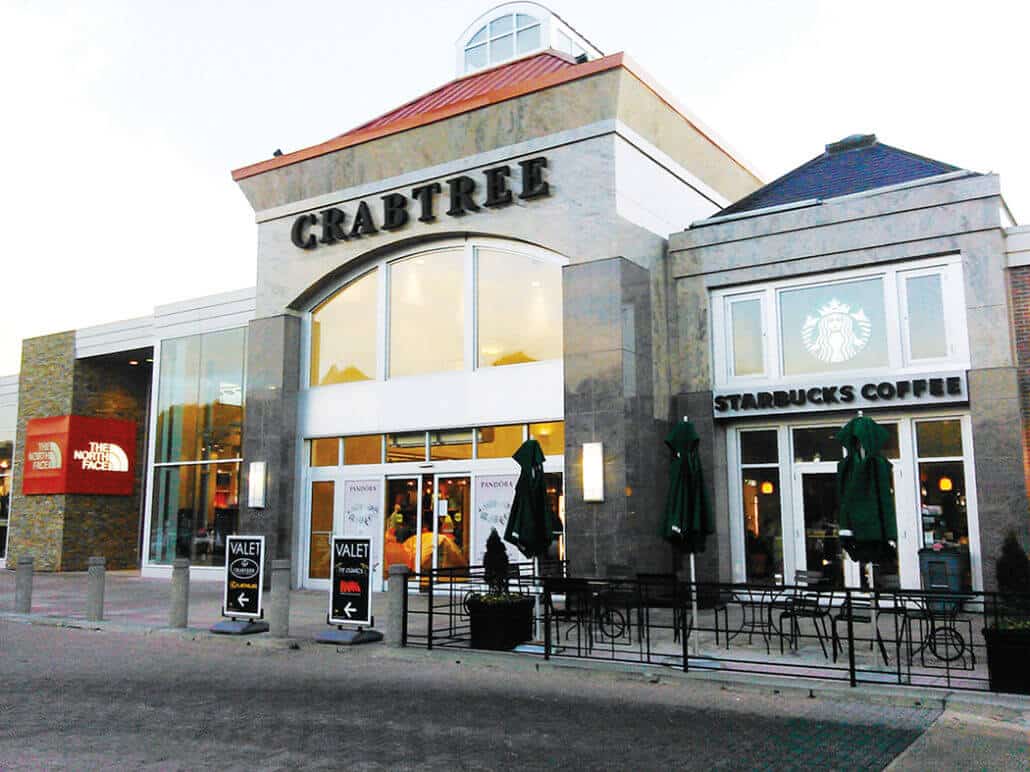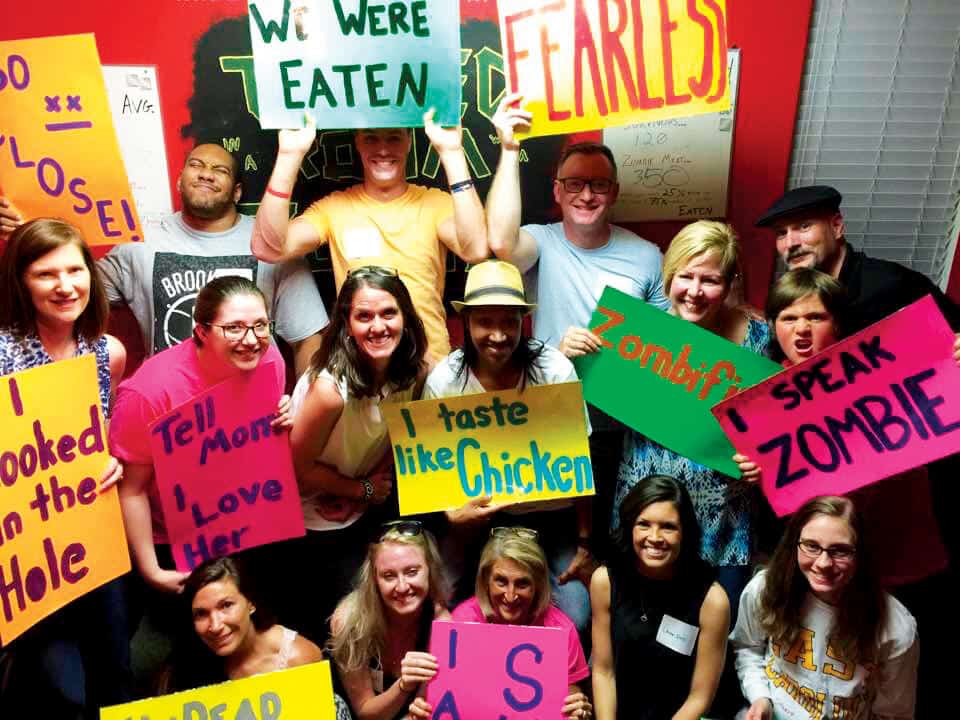Share this Post
A first-person account of the traumatic incident at Crabtree Mall
By Brandi Davis
Brandi Davis
The mall is usually the place I go to retreat from the real world. And, on Aug. 13, I was on a mission to find my little sister the best sheets and towels for her new apartment. As luck would have it, my college roommate was also in town for the weekend and needed to get her iPhone fixed at the Apple store so we headed to Crabtree. Being a type A personality, I needed to develop a plan to meet-up in case we were separated. We’d meet at the front entrance to Belk on the first floor at 3:45 p.m. sharp.
As my sister and I stood at the Belk’s counter later that day, a family by the “up” escalator caught my eye. They were just standing still, looking at something on the second floor. I noticed another family come up the escalator and look back with a strange look on their faces. That’s when I heard the most gut-wrenching scream. The kind of scream that was full of fear and panic. I thought someone had fallen backwards on the escalator. It was followed by another scream and then loud footsteps—people were running.
I grabbed my sister’s hand and looked back at the sales associate. We both had the sick sense that something awful was happening, but we didn’t want to acknowledge it. She answered the phone and said: “There is a shooter down in cosmetics.” I looked around and people were still shopping. They didn’t know. Others were running, but they didn’t know why. I heard an alarm go off and that was the only thing that got my attention. I was in shock. A shooter was in the building and so was I.
What I didn’t realize is that my husband, a former NC State Trooper, had been training me all along for what came next. I dialed his number. All those long car trips where we’d play the “what if” game were moments spent training me for life or death situations. He’s always told me to be aware of exits. I knew we needed run – be a moving target, not a sitting duck. I knew we had to leave quickly. When he heard my voice, he knew something was wrong. I could hear the despair in his.
He lived every moment of that awful experience with me. He heard me scream my sister’s name as she was telling others to come with us. We ran towards the back of the store; I knew not to go in the bathroom. I could hear him in my ear saying, “get out” and “find the stairs.” On my left, I saw two men in the stock room through the glass window. They were working on their computers and didn’t know what was happening. I couldn’t leave them behind. I busted through the doors begging for an emergency exit. There wasn’t an exit in the room. Panic set in. I looked behind me and 15 people were with us. One person said we needed to stay in the room and others agreed. My husband could hear all of the conversations and he started to scream: “No! You have to move. Don’t stay there. Run and take people with you.” So that’s exactly what we did. As we were running I heard people praying, “Lord have mercy, please.” I heard children screaming for their mothers. I saw people drop everything and run.
When we finally found the service entrance to the stairwell, I realized I had stopped breathing. We were getting out. I told my husband, Brad, I loved him. I didn’t know what was about to happen as we ran down the stairs or who was at the bottom, but I knew he could hear me. A lady and her husband in front of me told me to be quiet as we ran. I remember thinking “Yes, that’s right.” We didn’t want to draw attention to ourselves. Keep moving. I dragged my little sister with me. Those seven or eight seconds rounding the bend of every open floor were so traumatic. Not knowing where the shooter was.
When we hit the final door, I saw sunshine and immediately fell apart with emotion. We were out. We made it. Then, this awful feeling fell upon me, I didn’t know where my friend was. When we last spoke, she was on the first floor of Belk, so was the shooter. She didn’t have her phone; it was in the Apple store. I had no way of knowing if she had made it out. As I caught my breath and hugged my sister, I heard Brad say, “Get to the car.” I couldn’t leave my friend behind and she didn’t know where we had parked. I started to pray for her safety. Pray for our safety. Pray for all the families and loved ones that were in the mall that day.
Minutes passed that felt like hours and I got a call from a random number. My former roommate had memorized my number – the same number from college – in case of an emergency. I just started screaming her name until we found each other. Looking back I remember hearing others screaming for loved ones, people leaving strollers and jumping in vehicles to leave. It was complete chaos. Everything was gridlocked.
My immediate reaction was to get in the car and floor it, but my smart husband told us to sit still. To get in the back seat because the windows in my Jeep were tinted. The police hadn’t arrived yet. The shooter could still be at large. I don’t remember how long we sat in that parking deck waiting for traffic to clear, but I remember feeling completely numb. I didn’t know if there was a shooter or if there was a bomb or if it was a hoax. Whatever had just happened, it was real, raw and traumatizing.
Later that afternoon when I was back home, I was in complete denial. I felt fine or so I thought. That evening I had my first panic attack. The next morning at church I thanked members of our congregation for their prayers and concerns. It wasn’t until our associate pastor asked how we, both Brad and I, were doing that it hit me he was as traumatized as I was. He listened to every scream and cry for help. He heard the panic in my voice. We both experienced a life altering scenario which we had been preparing for unintentionally.
As I continue to process what has happened, I feel obligated to tell others to have conversations with their loved ones about moments of crisis. Ask your child or sibling what would happen if they were to ever get separated in a crowded space—especially with no phone. Remind them to always be aware of their exits. Take others with you and don’t leave them behind. And trust your instincts to run or hide.
While we still don’t know exactly what happened, there are lives will be forever changed by the incident at Crabtree Mall. The fear was real. Panic and cries of help happened. Mall workers who were trained in this type of scenario reacted to a real-life situation—they didn’t freeze. First responders were willing to risk their lives. When I look back on that painful day, I’ve chosen not to let the images of fear remain; instead, I’ll be reminded of the good I saw in others.
What to do if you’re in an active shooter situation?
“If someone is screaming shooter, don’t get into a mob mentality,” says Rick Hetzel, North Carolina State Bureau of Investigation SWAT Commander. “It’s hard for an untrained civilian, but take a moment and assess the situation then move towards an exit.” Here, he offers more advice.
1) Remain calm and do a 540-degree scan. What does that mean? Look 360 degrees around you then look up and down. This is especially important in a mall setting where there may be an open two-level area.
2) Anything will reverberate loudly in a mall so the threat may sound closer than it really is. If you don’t see a shooter, look for an exit. In fact, anytime you’re in a public area take notice of where the exits are so you can be prepared in the event of an emergency.
3) No exit in sight? Or there’s a stampede of people heading your way? Take cover and find something that can stop a bullet. It may be a bench, a table, or a nearby counter.
4) Don’t head into a bottleneck. An active shooter can easily open fire into a large crowd and hit a great number of people.
5) Keep your eyes open, continue to assess your situation and formulate a plan. You may need to mentally prepare to fight, especially if there’s nowhere to run. Or there may be a lull in activity, and you can safely find an exit.
Edge of Reason
The incident at Crabtree Mall underscores the importance
of community support in overcoming trauma
Within a span of days, two “active shooter” incidents occurred about 500 miles from one other. Both incidents sparked widespread panic, evacuations and security protocols yet neither turned up evidence of shots fired. Though ongoing investigations at JFK Airport and, in Raleigh, at Crabtree Mall are still determining what lead to each situation, one thing is clear: Many inside the mall or airport, who believed an active shooter was on the loose, experienced trauma regardless of whether the threat was perceived or real.
“For some, learning there may not have been a shooter allows them to move on and not dwell on the incident,” says Psychologist Vanessa H. Roddenberry of Praxis Psychological Services. “For others, the perception that they were threatened by an active shooter, regardless of whether the shooter was real or not, can be deeply terrifying and requires support.”
Dr. Roddenberry assures that experiencing a stress reaction from a traumatic event is normal; it’s the body’s nervous system “reacting in a protective manner” as it attempts to make sense of the events. Some responses include difficulty sleeping, feeling guarded or easily startled, irritability or depression, increased fear and anxiety.
“For many people, these symptoms will subside over time as they begin to process and put into perspective what they experienced. However, if these symptoms continue for more than a month, it begins to make sense to talk to a mental health professional,” says Raleigh-based Clinical Psychologist Dr. Brad Rappaport.
“It’s actually estimated that about 70 percent of adults in the U.S. have experienced a traumatic event,” says Dr. Roddenberry. “However, while most recover, approximately 20 percent of those adults develop an extreme stress reaction that meets criteria for Posttraumatic Stress Disorder.”
With three major mass shootings in the U.S. this year, along with highly publicized violence in Paris, anxiety over similar scenarios occurring locally isn’t out of the ordinary. And, some studies suggest that one can experience trauma from learning that a violent event has happened to someone close to you.
“It is understandable that many people are on edge and anxious about public venues given the rash of shootings that have occurred over the past few years. These are horrific and unconscionable acts that are difficult to comprehend and often may leave us feeling helpless,” says Dr. Rappaport. “It is especially important to realize that although these things do happen, they are very rare events, and that we are mostly safe in our day-to-day lives.”
Dr. Roddenberry agrees that while tragic incidents do occur, fear can lead to avoidance and more anxiety, even though there isn’t any evidence that suggests the traumatic event would happen again. Going about your daily life “allows you to see that fear may be blown out of proportion,” she adds.
In fact, talking about your traumatic experience with your community and accepting social support is a key step in processing the event and overcoming the trauma. Similarly, the community must respond to those experiencing it with compassion and understanding.
Share this Post








